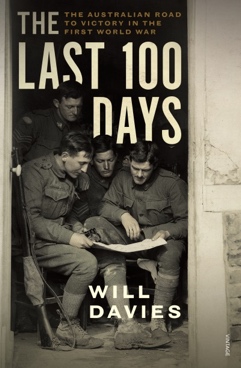When the Allies launched an offensive in the Amiens sector on 8 August 1918, the outcome was far from assured; but in the next 100 days, success begat success until Germany agreed to the Armistice on 11 November. After the fact, this period became known as the ‘Hundred Days Offensive’.
The Australian Corps was part of that offensive from 8 August until early October, participating in about 60 of the 100 days. After the capture of Montbrehain (5 October 1918) on the Hindenburg Line, it was withdrawn from the front line, although some elements of the Australian Imperial Force continued to be involved in offensive activities.

Much has been written about the battles of Villers-Bretonneux (24-25 April 1918) and Le Hamel (4 July 1918) as well as the early days of the Amiens offensive, but relatively little about the period from mid-August until early October 1918.
Davis sets the scene for this period with opening chapters on the German Spring Offensives, the defence of Amiens and the capture of Le Hamel. The bulk of the book then examines the preparation for and battles from 8 August onwards including Mont St Quentin, Péronne and Montbrehain. There is one chapter about the actions of the Australian Forces that were not part of the Australian Corps in those last few weeks of the war, as well as two chapters on the events of the immediate post-Armistice period.
The narrative is fast and animated with numerous quotes from the accounts of participants (drawn mostly from the official and battalion histories). Davis is unashamedly positive about the Australian’s performance and contribution and, at times, a little denigrating of other participants. The sub-title should more accurately say the ‘Australian contribution to Allied victory’. There is no mention of the pressure that Monash placed on the Australian Corps or the borderlining mutinous reaction.
Davies is an historian, writer and filmmaker. His previous books include: Somme mud: the war experiences of an Australian infantryman in France, 1916-1919 (Random House, 2008); Beneath Hill 60 (Random House, 2011); and The boy colonel: Lieutenant Colonel Douglas Marks, the youngest battalion commander in the AIF (Vintage, 2013).
The Last 100 Days includes 16 pages of black-and-white photos, three clear maps, notes, a recommended reading list, and an index. It is a good primer for those who are first encountering this period of the Australian Imperial Force’s history, but it is not a detailed or objective account and will have limited appeal to seasoned students of military history.
Contact Marcus Fielding about this article.






